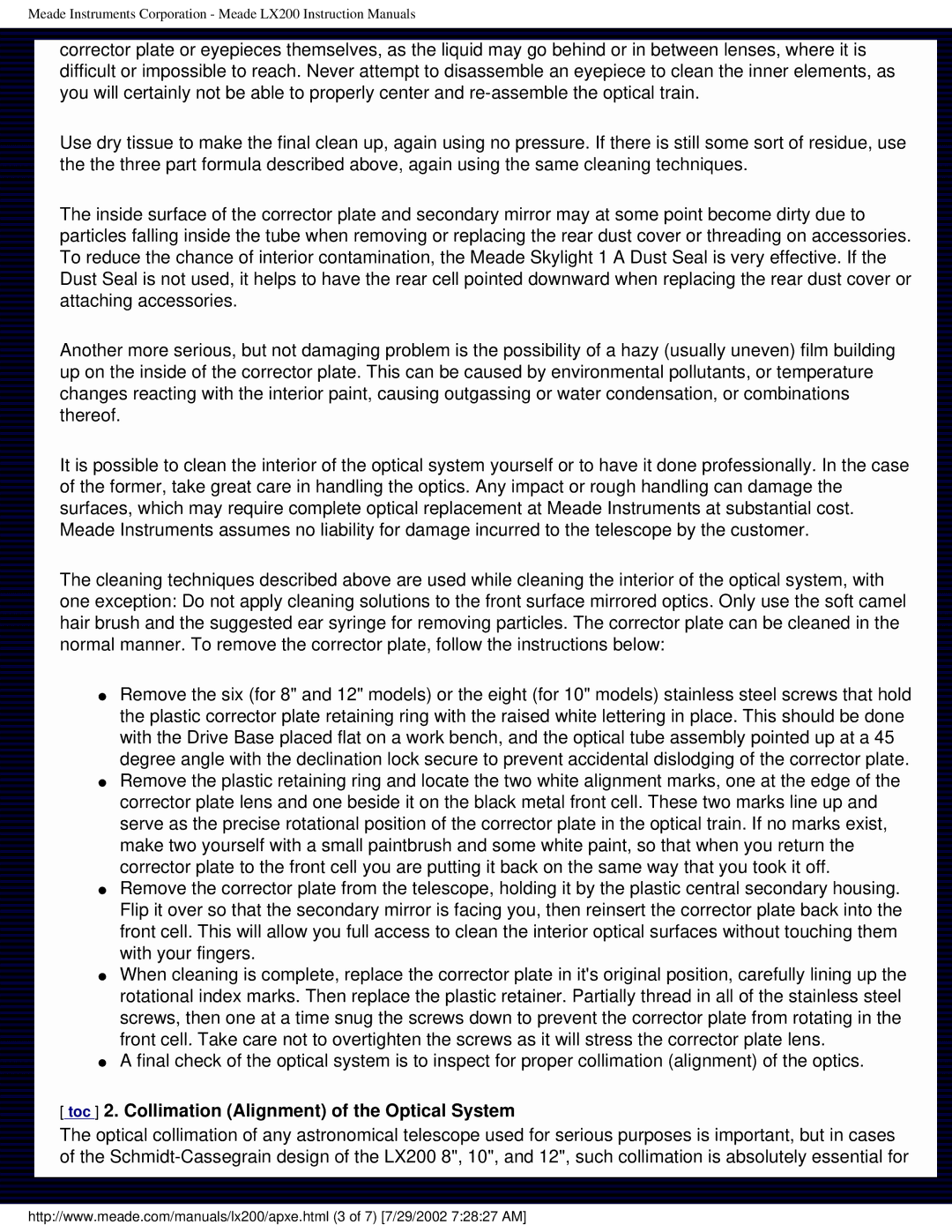
Meade Instruments Corporation - Meade LX200 Instruction Manuals
corrector plate or eyepieces themselves, as the liquid may go behind or in between lenses, where it is difficult or impossible to reach. Never attempt to disassemble an eyepiece to clean the inner elements, as you will certainly not be able to properly center and
Use dry tissue to make the final clean up, again using no pressure. If there is still some sort of residue, use the the three part formula described above, again using the same cleaning techniques.
The inside surface of the corrector plate and secondary mirror may at some point become dirty due to particles falling inside the tube when removing or replacing the rear dust cover or threading on accessories. To reduce the chance of interior contamination, the Meade Skylight 1 A Dust Seal is very effective. If the Dust Seal is not used, it helps to have the rear cell pointed downward when replacing the rear dust cover or attaching accessories.
Another more serious, but not damaging problem is the possibility of a hazy (usually uneven) film building up on the inside of the corrector plate. This can be caused by environmental pollutants, or temperature changes reacting with the interior paint, causing outgassing or water condensation, or combinations thereof.
It is possible to clean the interior of the optical system yourself or to have it done professionally. In the case of the former, take great care in handling the optics. Any impact or rough handling can damage the surfaces, which may require complete optical replacement at Meade Instruments at substantial cost. Meade Instruments assumes no liability for damage incurred to the telescope by the customer.
The cleaning techniques described above are used while cleaning the interior of the optical system, with one exception: Do not apply cleaning solutions to the front surface mirrored optics. Only use the soft camel hair brush and the suggested ear syringe for removing particles. The corrector plate can be cleaned in the normal manner. To remove the corrector plate, follow the instructions below:
●Remove the six (for 8" and 12" models) or the eight (for 10" models) stainless steel screws that hold the plastic corrector plate retaining ring with the raised white lettering in place. This should be done with the Drive Base placed flat on a work bench, and the optical tube assembly pointed up at a 45 degree angle with the declination lock secure to prevent accidental dislodging of the corrector plate.
●Remove the plastic retaining ring and locate the two white alignment marks, one at the edge of the corrector plate lens and one beside it on the black metal front cell. These two marks line up and serve as the precise rotational position of the corrector plate in the optical train. If no marks exist, make two yourself with a small paintbrush and some white paint, so that when you return the corrector plate to the front cell you are putting it back on the same way that you took it off.
●Remove the corrector plate from the telescope, holding it by the plastic central secondary housing. Flip it over so that the secondary mirror is facing you, then reinsert the corrector plate back into the front cell. This will allow you full access to clean the interior optical surfaces without touching them with your fingers.
●When cleaning is complete, replace the corrector plate in it's original position, carefully lining up the rotational index marks. Then replace the plastic retainer. Partially thread in all of the stainless steel screws, then one at a time snug the screws down to prevent the corrector plate from rotating in the front cell. Take care not to overtighten the screws as it will stress the corrector plate lens.
●A final check of the optical system is to inspect for proper collimation (alignment) of the optics.
[ toc ] 2. Collimation (Alignment) of the Optical System
The optical collimation of any astronomical telescope used for serious purposes is important, but in cases of the
http://www.meade.com/manuals/lx200/apxe.html (3 of 7) [7/29/2002 7:28:27 AM]
